I was gonna do an article on this this last year, but it’s so abstract. I touched on it in the article- What Makes an Ukulele Good? but mainly pointing out that the design and skill of the maker is the first determinate of tone. Great builders adjust to the woods attributes.
Beyond all of those other considerations, woods do make a difference. This is the material that is transmitting the vibration that makes the sound. The density and makeup of their cell structure in conjunction the other factors is what determine it’s tonality. Here’s my mix of facts and opinions on the most common woods used.
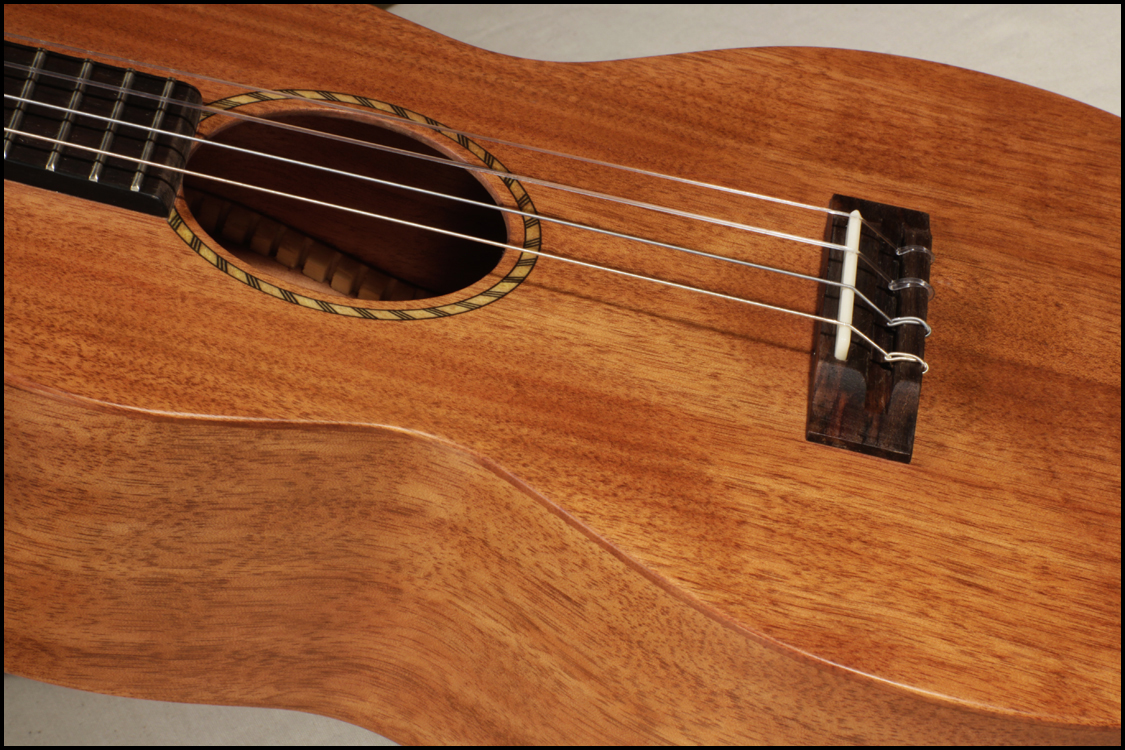
Mahogany: This is one of, if not the most common wood used for musical instruments. In the ukulele world almost everyone uses it for their neck. It has great strength at lower weights. Mahogany is a hard wood but in the middle of the spectrum. It is much less dense than other hard woods like rosewood and most exotic dark woods, and more dense than softwoods like spruce and cedar. Early on it became the ukulele sound. Almost every Martin Ukulele was an all mahogany body. It produces a focused sound. Thicker in the low mid and high mids. As a top, or soundboard, it is less bright in tone than softwoods, but more “punchy” in the mids. The problem with having a hardwood top is they are often too thick and don’t sound “open” . But done correctly, all mahogany is amongst the best tonewoods . At about the same density though, their is a more exotic wood, an alluring island tree vibrant in look and sound…
 Koa is the wood most synonymous with the Ukulele. The sound is more direct with less overtone but good sustain and great attack strumming or picking. Very mid range. It’s coloring is heard in almost every ukulele made in Hawaii. The indigenous wood has become the indigenous sound. And it’s physical attraction is strong. Many of us have experienced it.
Koa is the wood most synonymous with the Ukulele. The sound is more direct with less overtone but good sustain and great attack strumming or picking. Very mid range. It’s coloring is heard in almost every ukulele made in Hawaii. The indigenous wood has become the indigenous sound. And it’s physical attraction is strong. Many of us have experienced it.
Most builders recognize the top, or the soundboard is responsible for over 90% of the sound. Most with a quest for amazing tone on the ukulele will end up contemplating which wood for the soundboard. These three are the most loved..
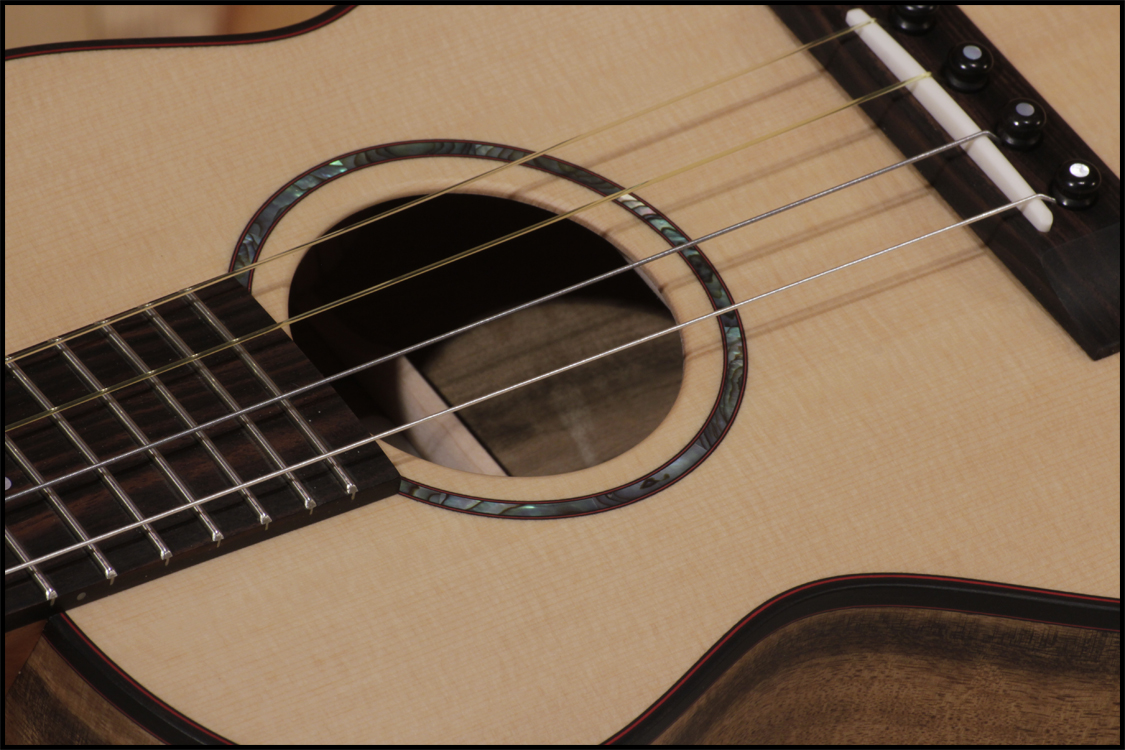 Spruce: is a softwood but very strong, crisp, and vibrant. Known for being bright, and loud , yet still full and warm. What do we mean when we describe sound as warm? It’s the emotional warm… I think? The harsher tones are not there. or maybe it is heat related warm, because of how that makes you feel good. Could sound be temperature related? Anyways, to me “warm” denotes strength in the mids and lower register, filling out the sound with a bed of warmth. lol. Spruce excels across the range of frequencies and it’s dynamics are arguably the best. There are different types of spruce but we can go over those in another post.
Spruce: is a softwood but very strong, crisp, and vibrant. Known for being bright, and loud , yet still full and warm. What do we mean when we describe sound as warm? It’s the emotional warm… I think? The harsher tones are not there. or maybe it is heat related warm, because of how that makes you feel good. Could sound be temperature related? Anyways, to me “warm” denotes strength in the mids and lower register, filling out the sound with a bed of warmth. lol. Spruce excels across the range of frequencies and it’s dynamics are arguably the best. There are different types of spruce but we can go over those in another post.
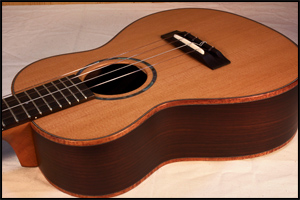 Cedar: is the second most common soundboard wood that you see in ukuleles. It is softer than spruce, with less pointed mids but often more bass. You also get more complex overtones right off the bat with cedar. It’s alive, sweet, and has just the right bite.
Cedar: is the second most common soundboard wood that you see in ukuleles. It is softer than spruce, with less pointed mids but often more bass. You also get more complex overtones right off the bat with cedar. It’s alive, sweet, and has just the right bite.
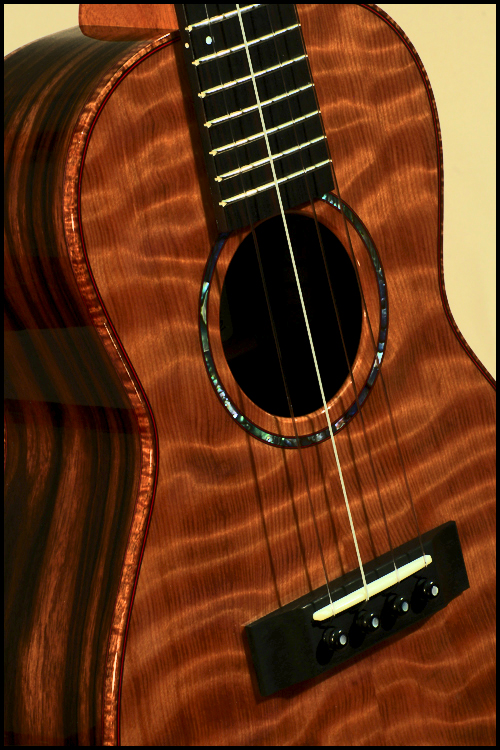 Redwood has much of the quality of cedar but very unique. A big, full voice many think is the best and others hear as unfocused. A spatial feel but not as cutting in the highs.
Redwood has much of the quality of cedar but very unique. A big, full voice many think is the best and others hear as unfocused. A spatial feel but not as cutting in the highs.
So we mentioned Mahogany and Koa that is most often used for the entire body. When there is a soft wood top, like the ones we just looked at, there is often koa or mahogany sides and back, both of which are very responsive and excellent choices. Other top choices include these woods-
Rosewood sides and back (seen above with the cedar top) is often used for the flagship models of acoustic guitar brands. It is not often seen in the uke world but when it is, you can often be impressed with the added mid range and low overtones. Rosewood even thickens up the higher range. Most often Rosewood is paired with a softwood top, but Ko’olau offers an all Rosewood model that sounds great. Otherwise pair rosewood sides and back together with a Cedar or Spruce top and get tones many consider to be the best.
Maple is renown for it’s clarity, less overtone clutter strong dynamic ability. Clean and also fat when done right. Maple sides and back are on some of the best sounding ukes you will find. Excellent for recording and often paired with Spruce.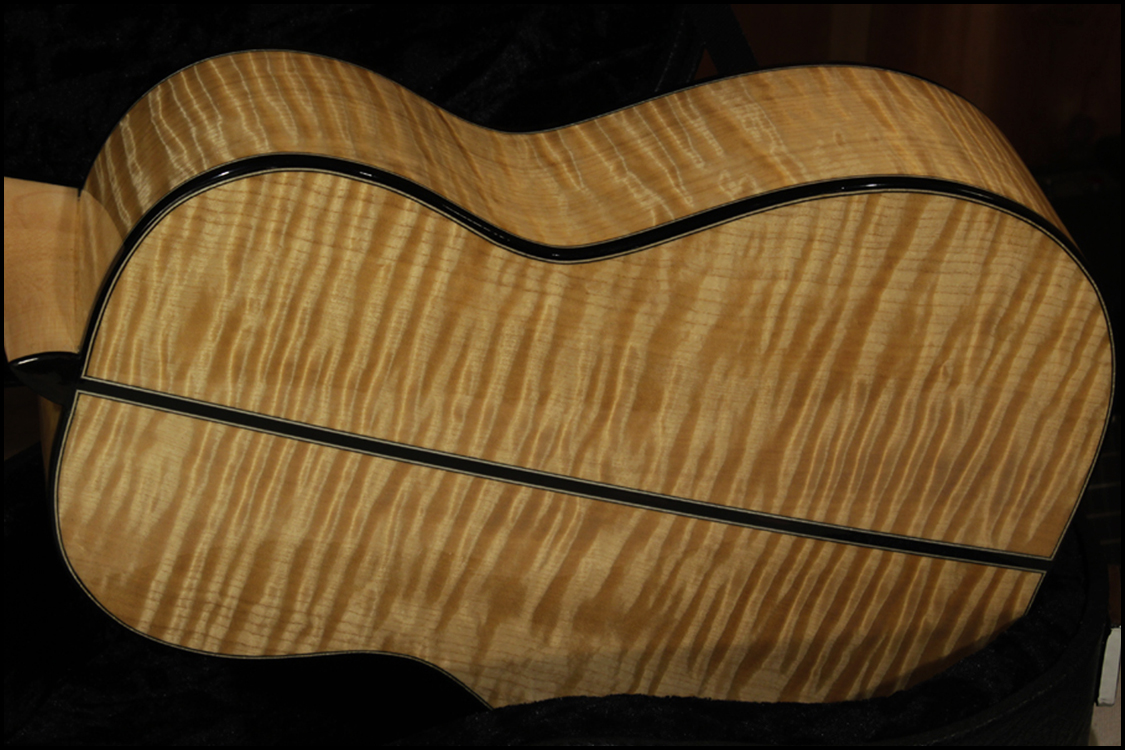
So that’s the basics, the most common woods you will see when looking for an ukulele. There are many other options. But we will look closer as they come by. a hui ho.

Comments 54
Hi,
I really enjoyed your review. I have been thinking about upgrading my ukulele. I recently saw one that I like. It is constructed almost entirely from a single slab of premium grade birdseye maple. The bindings are Bolivian rosewood and the bridge is carved from Australian blackwood. The combination is different from what you described. May I know will this combination make a good ukulele?
Thank you,
Winnie
Birdseye Maple is so beautiful. A Maple top typically does not project or have the “body” of softer tone woods like Spruce or cedar. It’s quite a bit harder than mahogany or koa also, but a good builder will adapt to the density and I have heard some real nice all maple ukes. Good luck!
Hi Andrew,
Thank you for the quick reponse. If I ask the maker to switch to a softer wood, will that combination make the ukulele sound better? Or is it more of a personal preference on how the ukulele sounds?
Yes, I would ask for a spruce top with Maple, but it is all personal preference. You will get a bigger projection but I can’t assume that’s what you want. That is what I like. You would rarely find a Maple top guitar because it is known as being more optimal for sides and back and softer woods are more often used as soundboard or top tone woods. Like I said though, a good builder will make it sound nice either way. Thanks
Great review of tone woods. Lots of great woods and wood combinations. As noted, it isn’t only the wood it is also the builder but having great wood is a nice start.
Ukes have come a long way. Even laminate (plywood) ukes can sound good.
Again, it depends on the luthier.
So true. Years ago my hubby bought a very cheap laminated zebra wood uke from China -about £12. I had been looking at a solid wood one for a couple of hundred but couldn’t afford it. When the cheap one came I was amazed at the sound. Bright and vibrant and once I had put decent strings on (Ken Middleton’s Living Water) it turned out to be a brill ‘throw in the car/bag etc uke. Even now there isn’t a scratch on it. Only a mark where the original make had been rubbed out for s9me reason which was Homeland.
Great review – thanks for all the info.
I find that the all hard wood instruments (mahogany and loa) are more forgiving to the novice player. Redwood, cedar and spruce in particular seem to make mistakes more apparent.
I started playing a few different softwood tops. I still have a redwood topped tenor, but I really do love my all mahogany ukes too.
… consistently providing relevant information … thanks to all the Staff @ HMS …
Author
Thanks Eric!
Thanks for the detailed descriptions. When trying to decide which ukuleles to buy online, the subtle points (the like the feel of the wool in a sweater) are hard to determine from just a picture. This helps.
/Bob
What are your thoughts on a KOA side and back with a port oxford top ukulele? I am looking at having a pineapple made with this wood combination. Thank you
Author
You must mean Port Orford Cedar? That could be nice. Here is a Ko’olau that we had a while back with that for a soundboard- http://www.theukulelesite.com/koolau-cs-port-orford-cedar-rare-tiger-myrtle-custom.html
Port Orford Cedar is not actually cedar, it’s a cypress wood and is a higher density than the western red cedar. A good builder builds to the wood and can take almost any tone wood and make it sound good. Personally I would pick a regular cedar top if I was commissioning a custom.
Thank you. I think it is too late to change the top now but I suspect it will still sound good. I will let you know my thoughts on this selection. I appreciate your feedback.
The Western Red Cedar is also not a true cedar, and a cypress
Author
This is true Po. Thanks!
I have KOA ukes that produce a mellow and rich tone. KOA seems to project the most. Spruce seems to me on the “bright” side, Mahogany sounds the closest to KOA. All in all, I prefer KOA to any other wood.
I previously owned a Pono Koa and now have a Kanilea Koa. I have played many other ukuleles with different wood and I still like the Koa best. And it gets so much better with age!
Does anyone have thoughts on the sound of an all solid wood mango ukulele? I’m surprised it’s not listed above due to the Hawaiian historical connection with mango wood.
Author
Yeah, good point. We should list it here. It has about the same density as mahogany but can vary. Especially the more figured mango needs to be cut and dried properly or it will have issues. I personally love the tone of some mango ukes. If used correctly it can be even sweeter than koa and even warmer than mahogany.
I have had a Melody Uke (circa 1930/40’s) since 1982 which my good lady wife Lynda bought for me in Castleford (West Yorkshire – the birthplace of my father incidentally) but, until recently have forgotten about. However, I’ve picked it up again and retuned and re-stringed it again from a old-style D6 tuning to a more modern C6 tuning with Aquila strings.
Moreover, I have accumulated recently, a nice tidy sum of cash of birthday and Christmas money and went along to The Music Room in Cleckheaton (West Yorkshire – again) where I fell in love with the Lani range of ukuleles. I purchased a Lani LC70 (concert) solid spruce top/mahogany back and sides ukulele and have fallen overboard. Since then I’ve bought a Stagg solid mahogany top/back and sides soprano which has a lovely warm sound even now and in 6-12 months will sound even be better.
Since then I have purchased a couple of basswood soprano ukes – priced at £20 each : for presents – and a couple of spruce laminate tops (at really reasonable prices – honestly) and am now looking at a maple top soprano and a spruce-top tenor from the same store!
I am not an advocate of any store but, everyone of this store’s staff are genuine working musicians and impart their expertise free of charge.
I want to buy a ukulele for a friends birthday. Would it possible to ship my purchase to an Australian address? as I will be in the Gold Coast next weekend.
How long would it take for it to arrive?
Thanks
Mii
Author
We regularly send to Australia but I am not sure it would be there in time. It takes about a week for the setup to be completed and it to be on the way and about a week in transit.
I am currently arranging to have a tenor ukulele made from Khaya with a Spruce top, the luthier involved tells me that it is a good combination, what do you think?
What are your thoughts regarding a Douglas Fir top and Walnut sides and back for a wood combination?
Thanks
Author
I don’t have any experience with Douglas Fir beyond house and furniture use. It’s an inexpensive option generally and is heavier than other soft woods that I would think would sound better. But I have seen some pretty good builders use it. Never personally tried them from what I can recall. Sorry I can’t shed more light on that option. Walnut is beautiful and has nice tonal character on the sides and back though. Mahalo.
Hi, I have a question about varnish finish.. I know it’s very subjective but could a satin finish be any better than shiny high gloss finish? Does it mean one is thicker and/or harder than the other? A youtube interviewer said his Koa wood Uke sounded better because it was mat/satin finish compared to a Mango wood high gloss Uke. So, the question is: is it the wood that is better or the varnish finish also affects the sound or both? LOL sorry ..long explanation..
Author
Hi Lester. First of all it depends on the type of satin and type of gloss and how well they are finished. A “satin” can be anything from a few coats of tru-oil to a sprayed lacquer where the final coats have a dulling agent to take out the reflective aspects of the finish and make for a more natural woody look. Similarly what they call gloss can range from a more extensive french polish that hardly adds any mass on the top to a thick polyester gloss that does. Considering both are the lacquer finishes gloss will not be much if any thicker than satin when done correctly and the sound difference will be negligible.
I’m looking to order a Pono in either solid Acacia, Mahogany, or Mango. A friend of mine has a Mahogany and I really like the sound. I won’t be able to play the other two before deciding. Can you give me a basic idea of the difference in tones the other two would have? I’d especially be interested in anything you can describe about Mango because I’ve never heard it. Thanks
Author
Hi Dan, I do a video comparison and we discuss the three models here- http://www.maryland.cochranfirmcriminaldefense.com/2015/04/12/listening-to-ukuleles-online/
Hello! I’m looking to buy an Alvarez brand tenor ukulele that has either a solid acacia body or a spruce top and mahogany back and sides. Which is better? between the two same models, the acacia is a little more expensive than the spruce and mahogany combo. Which do you prefer for mainly finger-picking songs with a lot of range? Thanks so much!
Author
Hi Gabriel, I would go for the spruce top.
Thank you for great information!! I bopped around on net after reading this, and think cedar top baritone vids have an absolutely lovely tone.
Author
Yes! They do.
looking at an Okoume wood uke for my teenager. she sings and plays guitar with our church band, and i’m wanting this for her 17th birthday. I did, however, do a search where the okoume wood may cause allergic reactions, perhaps even severe. Is this a good wood for such an instrument? ih ear it’s like cedar, but your review did not specifically cover it. thank you!! great info and so glad I foundyour site! -veronica’s mom-
Author
Okoume is like a really lightweight mahogany, maybe between mahogany and cedar. We’ve sold plenty of ukes with that wood without anyone having issues worth allergic reactions.
What are your thoughts on a Tenor POC top with Birdseye maple b/s. I’m having mya-moe build me one currently with walnut binding.
Author
Port Orford Cedar is a great wood and can be great. It’s a very stiff wood and works best for those that like to lay into it a bit more. For light picking I’d say a typical softwood, spruce, cedar, or redwood are better.
Hi, a few years ago I got a plastic Kohala uke as a birthday gift from my parents. I am trying to learn how to play some songs but I keep finding that my uke doesn’t sound the same, and in my opinion as good as other ukes in the video tutorials I watch. I haven’t seen anyone with a plastic uke so I decided to ask here, does it sound different because it is made out of plastic, not wood? At first I thought the reason it sounded different was because most of the ukes in the tutorials were concert ukes, and mine is a soprano. After looking around for concert ukes, and seeing what price I might have to pay for one, I realized it might be because it is plastic but I can’t find any defendant answers so far. I would really appreciate it if you could give me an answer, and if you don’t know, I’m sure I can find it somewhere else eventually.
Author
Yeah, plastic ukes definitely sound different from wood ukes. Some aren’t too bad, but most sound…plasticy?
I’m in the process of setting up to build my first uke – a concert with Kasha bracing style. I’m thinking of a spruce top with either walnut back and sides or cherry back and sides. Any thoughts on these hard woods. Does the density of the wood in the back and sides affect the tone as much as the top?
Author
Hey David, The top makes the biggest difference. But sides and back definitely affect the tone. I like walnut a lot. Cherry…sometimes..
Kala has a solid pacific walnut tenor, I noticed you guys don’t carry it, but have you played it? If so, opinions?
Author
Hey Mark, Those are laminate. We carried them for a while. With a setup any of the Kala models are a great value.
What do you mean with a setup?
I’m pondering between two Kala Tenors: Pacific Walnut KA-PWT and Mahogany KA-TG.
Which one do you recomend?
Author
More info on setups – https://www.theukulelesite.com/ukulele-setup/ Between those two I’d say the KA-TG is a better value, that’s my personal opinion. Both are laminate so woods are not the biggest factor.
Are some woods better for tenor than concert or soprano? I’m thinking of getting a tenor with a low g but are there some woods better for a low g rather than a high g?
Author
No necessarily. A low G tuning can be used for any size or wood and will just add some range on the lower end.
Hi Andrew, I have been reading your posts and found the information helpful. There was a reply to Dan Stolfus on 28 February 2016 that had a link to a video which compared the 3 different solid wood, Acacia, Mahogany and Mango. That link is broken. I am very interested to watch it and in particular find out more about the mango wood that makes a uke. You also mentioned that if the mango wood is not cut and dried properly, it can have issues. Is that not true for all wood? What do you think of the brand Makai? What is your website link to the online shop please?
Author
Hi Amy, here’s the link – http://www.theukulelereview.com/2015/04/12/listening-to-ukuleles-online/
So yes, that is true of all woods. It’s just that we have seen many mango ukes without properly quarter sawn woods and so I thought I’d mention it. Makai are good, we carried them for years but mostly in store because they often have cosmetic issues. They’re made in the same factory as Ohana and these instruments are a good value. Just often with small cosmetic issues. Mahalo!
Hi Andrew
Thank You for the lovely information.
I’m currently interested in 2 instruments on your website
1. Kala Soprano Long neck Solid spruce top with Mahogany back and sides
2. Kala Soprano Solid spruce top flame maple
The only difference I can find between the two other than the long neck is that one is Mahogany and the other Maple.
Am I correct?
How much of a difference in sound and intonation is there between the two? Or is it more a case of the Flame Maple is prettier?
I’m not too fussed by the neck length either way so for me the deciding factor will be the Ukulele with the better sound.
That being said, how much of a benefit is the long neck and should that not be the decider?
Thank you
Author
Well those two models both sound great. The sides on both are laminate with a solid spruce top so not much difference there. But the longneck will give a bit more punch, clarity, and sustain with the longer scale. The shorter scale regular soprano will be a little warmer and more mellow which is nice too.
Thanks so much. Long neck it is!
I’ve been thinking of getting a ukulele to begin my musical journey. There is a Martin “Iz” model which is beautiful and I know Iz played a vintage Martin. I also love the Hawaiian built ukuleles made with Koa. Hard choice for me. Any thoughts?
I love my solid all Koa 6-string Kamaka tenor ukulele, my laminated all Koa Fender tenor ukulele and my Oscar Schmidt Spruce-Koa tenor ukulele. I love the sounds of Hawaii that come out of Koa made ukulele.